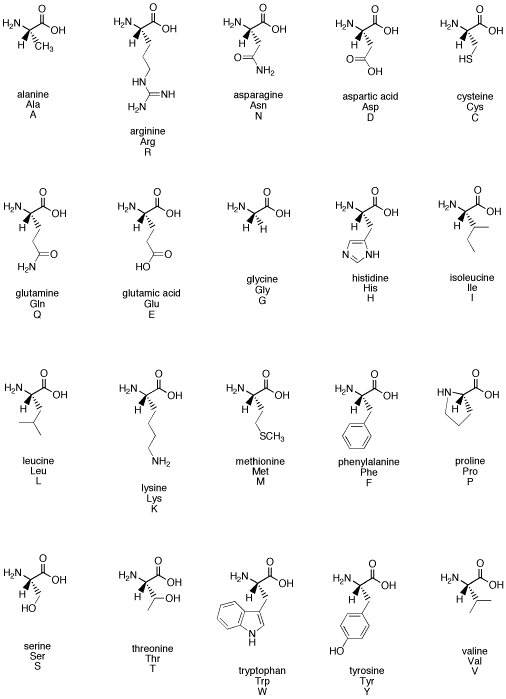SC12. Biological Building Blocks: Amino Acids
- Page ID
- 4118
One of the most important classes of biological chiral compounds is the amino acids. Amino acids are building blocks that are used to make peptides and proteins. Peptides can be used as hormones, carrying messages throughout the body. Proteins can be used as factories to carry out transformations, such as the formation of a neurotransmitter or the degradation of a toxin. The structure of peptides and proteins depend on the structures of the amino acids that make them. In turn, these shapes determine into what receptors peptide-based hormones can fit, and also what substrates protein-based enzymes can accept.
- Almost all of the naturally-occurring amino acids are chiral. In general, these compounds all have the same L-configuration.
Figure SC12. The common biological amino acids.
- Amino acids get their name from two "functional groups" or groups of atoms common to all these compounds.
- One of these groups is a carboxylic acid, the (C=O)OH on each amino acid.
- Later, we will look at how carboxylic acids can donate protons.
- The other common group is an amine, the NH2 group connected to a tetrahedral carbon in most of these compounds.
- Later, we will see how amines can accept protons. In general, amines are bases.
Problem SC12.1.
One of the amino acids is not chiral. Which one?
Problem SC12.2.
One of the amino acids has an enantiomer and also has diastereomers. Which one? Draw both diastereomers.
Problem SC12.3.
One of the amino acids does not have an NH group. Which one?
Problem SC12.4.
Which of the amino acids contain more than one carboxylic acid?
Problem SC12.5.
Which of the amino acids contains more than one amine?
Problem SC12.6.
Draw D-alanine.
Problem SC12.7.
One of the amino acids has a configuration (R or S) that is the opposite of all the others. Which one?



